Cat Translator Apps? Do They Really Work? Is It Even Possible?
I used to ask myself these questions every time my cat meowed, purred, or gave me that mysterious stare. Could an app really help me understand what my feline friend was trying to say?
I’ll admit it: I’ve held my cat’s face like a furry Hamlet and begged, “WHAT DO YOU WANT?!” Spoiler: She blinked. Slowly. Then licked her butt.
Cat translator apps promised answers. But after testing 14 of them (and being judged by my cat the entire time), here’s the hiss-terical truth.🐾
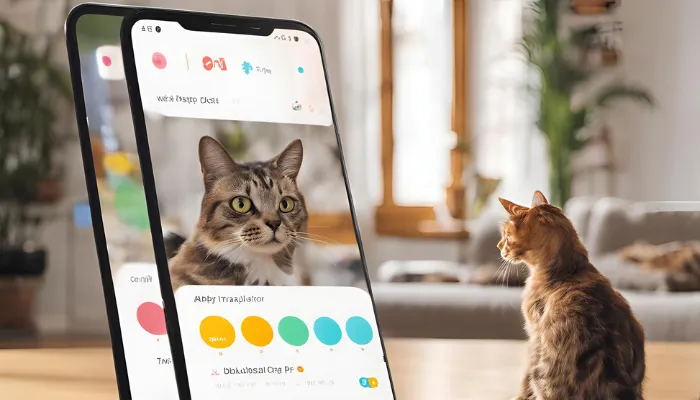
Does Cat Translator Apps/Tools work?
First things first: how do these cat translator apps even claim to work? Some cat translator tools, like Furlingo or PetTalk, use algorithms and databases of cat sounds to “translate” meows into human language.
A few even claim to have input from animal behaviorists, which sounds legit, right?
Picture this: Me, cross-legged on the floor, holding my phone like a meow Ouija board. Mr. Whisker saunters over, sniffs the screen, and delivers a dramatic “MRAOOP!” The app declares: “Let’s play! Bring the feather wand!”
Meanwhile, Mr. Whisker’s actual agenda? He’d just stepped on a crinkle ball. It was a war cry.
Here’s what I learned:
1. Apps Speak “Human,” Not “Cat”
Tools like Furlingo use fancy algorithms and meow dictionaries. But cats? They’re freelance vocalists. That “feed me” meow at 5 AM? To another cat, it probably means, “Human slave, awaken and grovel.”
2. Your Cat is Basically a Shakespearean Actor
One morning, Mr. Whisker’s “mrow?” became “My kingdom for tuna!” via PetTunes. Later, the same meow translated to “Cease thy paparazzi, peasant!” during a photo shoot. Consistency? Not their strong suit.
3. The Real MVP is YOU
After weeks of app-induced confusion, I realized: I’d already cracked Mr. Whisker’s code.
- Silent Meow + Blink: “You’re tolerable… for a hairless ape.”
- The Doorframe Rub + Purr: “Admire my floof.”
- Toe Bite at 3 AM: “Your suffering sustains me.”
Yes, cat translator apps do work—especially the good ones. They can be surprisingly accurate when it comes to decoding basic meows, purrs, and chirps.
But do we believe them 100%? I wouldn’t go that far. At the end of the day, we’re cat owners. We know our furry overlords better than any app ever could. We’ll always trust our instincts and observations over a digital translation.
That said, these apps can definitely help with basic day-to-day queries. Is Mr. Whisker meowing because he’s hungry, bored, or just feeling chatty? A translator might give you a clue. But remember, it’s just a tool—not a replacement for the bond you share with your cat.
So, if you’re curious, give one a try! Just don’t be surprised if your cat still manages to keep a few mysteries up their furry sleeve. After all, that’s part of what makes them so endlessly fascinating, right? 😸
Should You Try a Cat Translator App? Here’s the Tail…
PROS:
- Comedy gold (One app translated a yawn as “I crave intellectual conversation”)
- Helps spot patterns (Turns out, Mr. Whisker’s “mrowrl” means “Open the fridge NOW” 80% of the time)
- Bonding booster (Nothing says love like arguing with Siri over your cat’s tone)
CONS:
- Accuracy ≈ horoscope (“Vague but oddly specific”)
- Cats hate innovation (“Mr. Whisker side-eyed my phone into oblivion”)
- Risk of overthinking (“Was that meow a haiku or a grocery list?!”)
What is Cat Translator exactly?
Let’s break it down: A cat translator is basically your attempt to become Dr. Dolittle for your feline overlord. It’s a gadget, app, or software that claims to decode your cat’s meows, purrs, and dramatic flopping into something resembling human language.
The goal? To make communication with your cat less of a guessing game and more of a “Oh, so THAT’S why you’re yelling at 3 AM” moment.
But let’s be real—my cat, Mr. Whisker, thinks it’s hilarious.
How Does a Cat Translator Work? (Spoiler: It’s Not Magic)
Cat translators use a mix of science, tech, and a sprinkle of wishful thinking to try and crack the feline code.
Here’s the breakdown:
- Sound Recognition Technology:
This is where the app listens to your cat’s meows and tries to match them to a database of sounds. Think of it like Shazam, but for cats. It analyzes pitch, tone, and frequency to guess if your cat is saying “FEED ME” or “Stop singing in the shower, human.” - Behavioral Analysis:
Some translators go beyond meows and factor in body language. Is your cat pacing by the food bowl? Staring at you like you’ve personally offended them? These cues help the app make an educated guess about what’s going on in that tiny, mysterious brain. - Machine Learning Algorithms:
Fancy apps use AI to “learn” your cat’s unique vocal patterns over time. The more you use it, the better it supposedly gets at decoding Mr. Whisker’s dramatic monologues.
P.S. Mr. Whisker’s latest translation? A long, drawn-out meow became “Human, your existence amuses me.” Accurate? Probably. Humbling? Absolutely.
Why Would You Even Want a Cat Translator?
Okay, fair question. Here’s why I gave it a shot (and why Mr. Whisker now judges me every time I open the app):
Monitor Health:
Sometimes, changes in your cat’s vocalizations or behavior can signal something’s wrong. A translator might help you catch early signs of discomfort or distress.
Improve Communication:
Let’s face it—cats are cryptic little creatures. A translator can help you figure out if that meow means “I’m hungry” or “I’ve decided to redecorate the couch with my claws.”
Strengthen Your Bond:
Understanding your cat’s needs and emotions can bring you closer. Or, in Mr. Whisker’s case, it just means he gets his treats faster.
Reduce Misunderstandings:
No more mistaking a “play with me” meow for a “clean my litter box” demand. (Though, let’s be honest, Mr. Whisker expects both.)
Human to cat translator (and for that fact, cat to human traslator) can be a fun, quirky tool to deepen your understanding of your feline friend. It’s not perfect (and Mr. Whisker would argue it’s downright ridiculous), but it can give you some insight into what’s going on in that fluffy little head.
Just don’t expect it to translate “I love you” when your cat is actually saying, “Your lap is warm, but I still own you.”
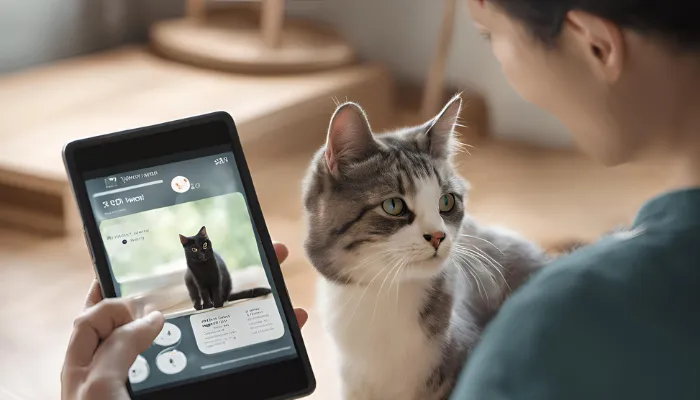
Popular Cat Translator Apps
If you’re looking for a top rated best cat translator apps, here are some of the best options available:
| App Name | Key Features | Platform |
|---|---|---|
| Furlingo | AI-based, records and translates meows, customizable dictionary | iOS & Android |
| Cat Translator Free | Simple interface, basic translations, free to use | Android |
| Human to Cat | Converts human speech to cat sounds, playful and fun | iOS & Android |
When choosing a cat translator app, consider the following features:
- Simple to Use: The platform’s layout is easy to understand.
- Flexible Word Bank: You can record a voice of your cat’s sound for personalization.
- High Communication Accuracy: The exactness, the improved communicative interaction.
- Free vs Paid Accounts: Choose if there is a requirement for the premium options.
Choosing the right cat translator app can make communicating with your feline friend both fun and effective.
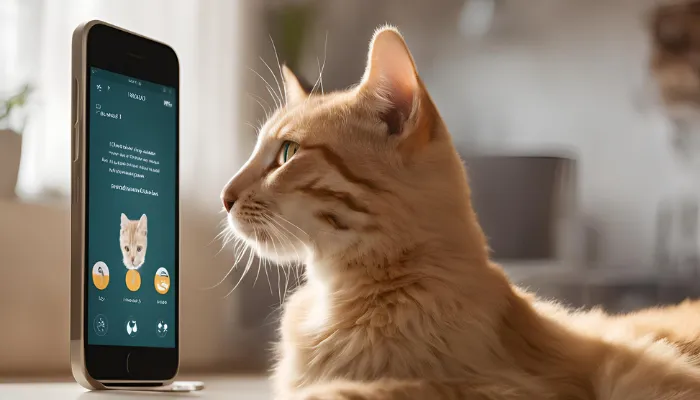
How to Use a Cat Translator Effectively?
Do you find it difficult to understand your cat? Cat translators use AI to make sense of quintessential cat sounds and help you understand what your feline buddy needs. While the technology is not perfect, it can deepen your relationship with your furry friend.
How to Use a Cat Translator:
- Download and Install: Download MeowTalk or Human to Cat Translator from your device’s application store or get other reputable cat translators.
- Create a Profile: Create an account for your paw friend and fill their details like name, age and breed. This ensures that the app registers all distinct vocal traits of your feline buddy.
- Capture Meows: Open the app whenever your cat makes a sound. Make sure to capture with the best clarity.
- Translate and Interpret: The app captures each meow and converts it into a text along with providing context that comes with it.
- Train the App: You can use a lot of apps nowadays to provide feedback and teach the app the suitable context which is valuable for the AI learning your cat better.
- Observe and Contextualize: Add your own understanding along with app translation. Pay a close look to your cat’s body language, actions, and the environment to deduce the context best.
Tips for Effective Use:
- Be Patient: Cat translators are in progress, and accuracy can differ. Don’t depend only on translations; combine them with your personal observations.
- Record Different Meows: Collect multiple meows from your cat to distinguish between them and comprehend its dialects.
- Use in Different Contexts: Capture meows in different contexts like during play, feeding, or when your cat is alone to understand the different emotions your cat conveys.
- Combine with Observations: Remember to always consider your pet’s body language, facial expressions, and actions simultaneously to have an accurate translation.
- Update Frequently and Train: Use the app consistently and provide feedback to help it improve further with every use.
Cat translators can be valuable tools for understanding your feline companion, but they should be used in conjunction with careful observation and consideration of context. By actively engaging with the app and training it to recognize your cat’s unique vocalizations, you can deepen your bond and gain a better understanding of their needs and desires.
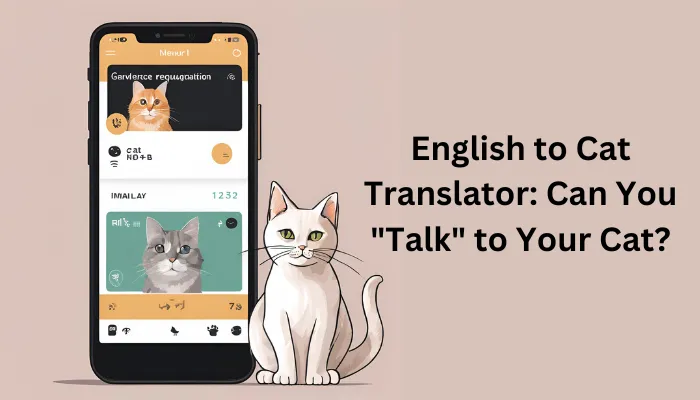
English to Cat Translator: Can You “Talk” to Your Cat?
An English to Cat Translator – as the name suggests – is a tool that translates human phrases into cat sounds, such as meowing, purring, or chirping, in order to communicate with one’s pet. Although cats may not comprehend spoken language, these apps and tools strive to reproduce sounds the cats could identify.
How It Works:
- Apps such as the Human-to-Cat Translator has a set of databases that store cat sounds for each unique phrase that is inputted. For instance, the phrase “dinner time” gives a command that may trigger agitated meowing from a cat.
- Other products are designed to emit high pitched sound that humans cannot hear. These sounds catch a cat’s attention as well as signal particular tasks or actions. For example, these sounds can be used to call cats indoors.
Limitations:
- More so than words, a cat will respond to its tone and body language.
- These products serve best as toys instead of a means of reliable communication.
At the end of the day, English to cat translators are meant to be playful rather than serious tools of communication.
Cat Meow Translator: Decoding the “Language” of Meows
A cat meow translator focuses on analyzing your cat’s vocalizations to interpret their meaning. Apps like Furlingo and Cat Translator Free use AI to categorize meows into emotions or needs (e.g., “hungry,” “angry,” “playful”).
How It Works:
- Record your cat’s meow in real-time.
- The app compares the sound to a database of categorized meows.
- It provides a translation (e.g., “I’m lonely!” or “Feed me now!”).
Accuracy Tips:
- Record meows in different contexts (e.g., at mealtime vs. during play).
- Train the app by confirming or correcting translations to improve its accuracy for your cat.
User Feedback:
- Many owners find patterns in translations (e.g., a specific meow always means “open the door”).
- Skeptics note that meows vary widely between cats, making universal translations tricky.
While not foolproof, cat meow translators can offer playful insights into your cat’s vocal patterns and emotions.
How to Speak Cat Translator: Beyond Apps
While apps help, learning how to speak cat translator involves combining technology with observation of your cat’s unique communication style:
- Learn Common Sounds:
- Short meow: Greeting.
- Drawn-out meow: Demand (e.g., food).
- Chirps/trills: Excitement or a call to follow them.
- Pair Sounds with Context:
- A meow at the fridge likely means hunger.
- A nighttime meow could signal boredom or a desire for attention.
- Use Body Language:
- Slow blinks = trust.
- Arched back + puffed tail = fear.
- Respond Appropriately:
- Answer “feed me” meows with food (if on schedule) to reinforce communication.
- Ignore attention-seeking meows at night to avoid encouraging bad habits.
Pro Tip: Use apps like Furlingo to identify vocal patterns, then tailor your responses based on what works for your cat.
By blending tech tools with keen observation, you’ll become fluent in your cat’s unique language in no time.
Science Behind Cat Communication
Understanding how cats communicate can make using a cat translator even more effective. Cats rely on both sounds and body language to express their needs and emotions.
Types of Cat Sounds:
Cats use a variety of sounds to communicate, each serving a specific purpose:
- Meows: As a vocalization directed to people, a cat’s meow can mean anything from hunger to annoyance. Cats can even modify their meows to vocalize specific needs to their owners.
- Purring: Generally a form of sound produced while contented, but it can also mean stress, displeasure, or even pain depending on the situation and the circumstances surroudning the cat’s behavior.
- Hissing/Growling: Classic symptoms of discomfort, fear, aggressive possession, or being in danger. These noises commonly act as precautions for others to keep their distance.
- Chirps/Trills: Most often a type of friendly “hello” or attention seeking call. Mother cats often try to lead their kittens with chirps, and some cats never entirely lose this when grown, using it when speaking to people.
Body Language and Behavior:
In addition to vocal cues, cats rely heavily on body language to communicate. A cat language translator should consider these subtle physical signals:
| Behavior | Possible Meaning |
|---|---|
| Tail Upright | A sign of friendliness and happiness; your cat is glad to see you. |
| Slow Blinking | A gesture of trust and affection, often called “kitty kisses.” |
| Ears Flattened | Indicates fear, anxiety, or aggression; your cat may feel threatened. |
| Kneading with Paws | A comforting behavior that harks back to kittenhood, when kittens knead their mother’s belly to stimulate milk flow. It can also indicate relaxation and contentment. |
| Arched Back | Can signal playfulness or fear; context and other cues will help you interpret it correctly. |
| Tail Twitching | Rapid twitching can indicate irritation or excitement, while slow swishing might show focused interest. |
| Dilated Pupils | This can signal excitement, fear, or surprise, depending on the situation. |
By combining an understanding of both vocalizations and body language, you can more accurately interpret your cat’s emotions and needs.
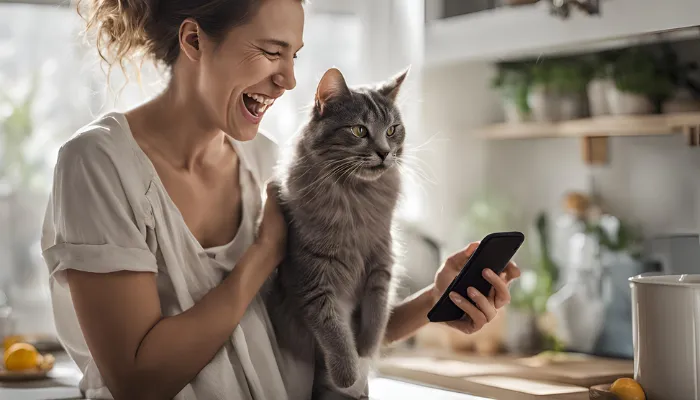
Are There Human to Cat Translators?
Although it may feel impossible to imagine an accurate human to cat translator existing in real-time, there are apps on the market that try to solve the communication barrier between humans and their cats.
These apps generally work in one of two ways:
- Translating Human Speech into Cat Sounds: Some of these apps allow users to talk to the phone which then translates whatever the user has said into sounds like purrs and meows. This is intended to get the attention of the cat or to send a message.
- Analyzing Cat Vocalizations: Some applications promise to interpret your cat’s meows by analyzing the sound. Based on common cat vocalization studies, these apps attempt to make a guess about what your cat might be trying to tell you.
It’s important to note:
- Accuracy is Limited: Apps that claim to ‘speak’ on behalf of your cat are quite fun, but tend to lack accuracy, so use them at your own risk! At the end of the day, they cannot pinpoint cat feelings perfectly.
- The Context Matters: Each meow has potentially 15 different meanings based on the context, so no app is going to provide an accurate translation. Even the most advanced one will not will get it right all the time.
Popular Human-to-Cat Translator Apps:
- Human-to-Cat Translator: This app’s main purpose is turning human language into cat language. It has a range of meows and purrs to choose from.
- Furlingo: This app works to record and translate meows with a noted database of cat sounds. It also allows you to capture your cat’s meows with the potential of teaching the app to recognize your cat’s specialized dialect.
Even if these applications don’t work totally, they can be a fun way to engage with your cat. Keep in mind that these “translations” should not be taken seriously without an understanding of your cat’s complete behavior and the situation surrounding it.
Cat Translator vs. Traditional Methods
When it comes to understanding your feline friend, both cat translators and traditional methods offer unique advantages. Here’s a comparison to help you decide which approach works best for you and your cat:
| Aspect | Cat Translator | Traditional Methods |
|---|---|---|
| Technology | Uses AI, sound recognition, and machine learning to interpret meows. | Relies on observing body language, behavior, and vocal patterns. |
| Ease of Use | Quick and convenient—just record and translate. | Requires time, patience, and consistent observation. |
| Accuracy | Varies depending on the app’s algorithm and your cat’s vocalizations. | Often more accurate as it’s based on proven behavioral cues. |
| Fun Factor | Interactive and entertaining, especially for curious cat owners. | Less playful, but offers a deeper understanding over time. |
| Customization | Some apps can learn your cat’s specific sounds over time. | Personalized as you learn your cat’s unique quirks and communication. |
| Scientific Backing | Some apps are developed with input from animal behaviorists but remain limited. | Grounded in well-established studies of feline behavior and signals. |
| Emotional Connection | Can enhance communication but might miss subtle cues. | Strengthens the bond through direct, intuitive understanding. |
| Cost | Many apps are free or low-cost, with optional premium features. | Free, but requires more time investment. |
Cat translators offer a fun, tech-driven way to understand your cat’s vocalizations, while traditional methods provide deeper, time-tested insights. Using both can strengthen your bond and improve communication with your feline friend.
FAQs
Curious about the nuances of cat translators and how to make the most of them? Here are some advanced questions cat owners often ask:
What is the best cat translator app of 2025?
Drumroll, please… Firlingo takes the crown! It’s the Beyoncé of cat translator apps, with glowing reviews on the App Store and a fanbase of obsessed cat parents. Why? It’s got advanced AI, real-time translation, and a sleek interface that even my tech-challenged grandma could figure out. Plus, it lets you create profiles for multiple cats—because Mr. Whisker deserves his own VIP account.
Are cat translator apps accurate?
Accurate? Well… let’s just say they’re more “ballpark guess” than “word-for-word translation.” These apps use fancy AI to analyze your cat’s meows, but cats are like tiny, furry poets—they don’t follow rules. So while an app might tell you Mr. Whisker’s meow means “I’m hungry,” he’s probably just saying, “Human, why are you holding that weird rectangle at me again?”
Can I use these apps for multiple cats?
Absolutely! Apps like Furlingo let you create profiles for each of your feline overlords. This way, the app can learn that Mr. Whisker’s “mrow” means “Feed me now,” while his sister’s identical “mrow” means “I’ve knocked over your favorite vase. You’re welcome.”
Are there free cat translator apps?
Yes, and thank goodness for that because Mr. Whisker already costs me a fortune in treats. Many apps offer free versions with basic features, like translating meows into “happy,” “hungry,” or “I’m judging you.” If you want the deluxe experience—like unlimited sound storage or mood tracking—you’ll need to shell out for the premium version
How do I choose the best app for my cat?
Think about what you and Mr. Whisker need. Want real-time translation? Look for apps with live voice analysis. Curious about his mood swings? Go for one with behavior tracking. Just want something simple and fun? Pick an app with a user-friendly interface and maybe a few cute cat stickers.
How to speak cat translator?
It’s easier than teaching Mr. Whisker to fetch (trust me, I’ve tried). Just open the app, let it listen to your cat’s meows, and watch it work its magic. Some apps even let you “talk back” by playing pre-recorded cat sounds. Spoiler: Mr. Whisker will probably ignore you.
How to say “I love you” in cat translator?
Ah, the eternal question. You can use the app to play soft purring or gentle meows, which cats associate with affection. Or, skip the tech and try the universal cat language: slow blinking. Stare at Mr. Whisker, blink slowly, and wait for him to blink back. It’s like a feline “I love you”—minus the awkwardness.
Are there any real cat translators?
Yes, and they’re not just a figment of my sleep-deprived imagination. Apps like Firlingo, MeowTalk, and Petcube Play 2 use AI and machine learning to decode your cat’s mysterious meows. Are they perfect? Nope. Are they fun? Absolutely.
Does a human-to-cat translator online work?
Kind of! These tools use AI to analyze your cat’s sounds and behaviors, giving you insights into their emotions and needs. Will Mr. Whisker finally understand when you say, “Get off the counter!”? Probably not. But it’s a step closer to world peace—or at least household peace.
Can cat translator apps detect health issues?
Some apps, like MeowTalk, can help spot potential problems by tracking changes in your cat’s vocalizations or behavior. For example, if Mr. Whisker starts meowing more than usual or making strange sounds, the app might flag it as a sign of stress or discomfort. Of course, it’s not a substitute for a vet visit—just a helpful nudge to pay attention.
Cat translator apps are like horoscopes for your cat—fun, occasionally insightful, but not something to base your entire life (or Mr. Whisker’s) on. Give one a try, and who knows? You might finally figure out why he yowls at the ceiling fan at 2 AM.
Conclusion
To summarize, a cat translator is a new and exciting tool for animal lovers who want to know their cats better. Whether you are using a human to cat translator, a cat language translator, or trying out the new cat translation apps, these gadgets are a fun way to increase interaction with your pet.
While they are unlikely to substitute measuring body language and observing a cat’s behavior, these devices make the task of interpreting meows and purrs more engaging. Wondering if a human to cat translator really works? Or how effective a cat language translator can be? Your relationship with your cat can benefit greatly from these technologies, together with your own careful monitoring. So why wait? Start translating today and see what messages your cat has for you.
